Ancient Aliens
And I'm back with another conceptual post, exploring ideas that run deep in the sci-fi community. And it's one that I find particularly cool, mainly because it's just so freaking existential! I mean what is there that can possibly throw a wrench into our collective anthropomorphism than knowing that there is sentient life out there that significantly predates our own. Especially if we were to find out that they had something to do with our evolution.
In some ways, this is a shout out to the "ancient astronauts" theory, which states that aliens traveled to Earth long ago and left some evidence of their visit behind. This can be limited to something as basic as a structure or a relic, or can run as deep as having influenced human cultures, religions and technological development. Regardless of whether or not this theory is taken literally, it is well represented in the genre of sci-fi. Here are some examples that I have assembled:
2001: A Space Odyssey: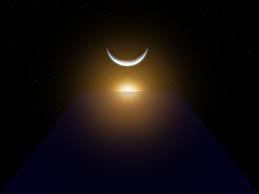 A classic example of an ancient species, ancient astronauts, and one of my personal favorites! Originally conceived in the form of a screenplay by Arthur C. Clarke and Stanley Kubrick, the concept of the TMA-1 monolith aliens became one of the most groundbreaking science fiction movies of all time. However, owing to Kubrick's esoteric style, not much was ever made clear about the species that built the monoliths. Luckily, Clarke wnet on to develop the idea at length in his novelization of the movies and its many sequels.
A classic example of an ancient species, ancient astronauts, and one of my personal favorites! Originally conceived in the form of a screenplay by Arthur C. Clarke and Stanley Kubrick, the concept of the TMA-1 monolith aliens became one of the most groundbreaking science fiction movies of all time. However, owing to Kubrick's esoteric style, not much was ever made clear about the species that built the monoliths. Luckily, Clarke wnet on to develop the idea at length in his novelization of the movies and its many sequels.
According to Clarke, the race that built the monoliths were an extremely ancient race that achieved sentience millions of years ago, by our standards. The monoliths were their means of traveling throughout the galaxy, which they did in order to seek out life and help it along. In the course of their travels, they came upon Earth several million years ago and discovered Simians who were on the verge of starvation. By teaching them to expand their diet through hunting and some basic tricks to cultivate their manual dexterity, they ensured not only the survival of higher order primates, but the eventual creation of humans.
The story of 2001 thus takes place in the near-future (from when it was originally written) where humanity has developed into a star-faring race and colonized the Moon. Not far from their colony, a monolith is discovered buried under millions of years of dust. After examining it, to no avail, they discover that it has sent a signal out to Jupiter. The ship Discovery is dispatched to investigate, where it finds an even larger monolith is discovered near Europa. In subsequent books, humanity realizes what the monoliths are and determines that they are still at work, transforming Jupiter into its own star so that life may blossom on Europa (which scientist speculate is already home to a number of maritime species).
Cool idea! But you see, there's a snag… Apparently, the ancient species that built the monoliths have also been known to weed wherever they've sown. What would happen if they came to the conclusion that humanity was too aggressive for its own good, the result of them teaching us to harness an appetite for killing other animals and members of our own species? This is the premise that is explored in the finale 3001, one which was deliberately left open…
Alien vs. Predator:
Note: this is not a reference to the terrible movie or its even more terrible sequel! No, in this case, I am referring to the wider franchise, as exemplified by its many video games, comics, novelizations, and even the independent (non-crossover) movies. In these cases, we get a glimpse of two races that predate humanity by hundreds of thousands or even millions of years. Their outward characteristics alone make them cool, and they are both pretty badass in their own special ways. But what is especially cool about them is the fact that very little known about them, other than the fact that they are very, very dangerous!
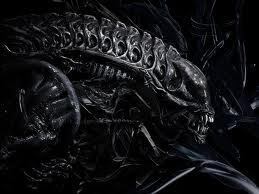 "I admire its purity. A survivor… unclouded by conscience, remorse, or delusions of morality". That is how the Alien, or Xenomorph in AVP terminology, was described in the very first movie. Their origin is unknown, as is the timeline of their existence and the circumstances of their evolution. However, one thing is clear: on this last note, it must have been something pretty harsh! I mean really, how difficult must life have been on their homeworld for something like the xenomorph to have emerged. They proliferate at an alarming rate, require living being to gestate, and are designed purely for the hunt!
"I admire its purity. A survivor… unclouded by conscience, remorse, or delusions of morality". That is how the Alien, or Xenomorph in AVP terminology, was described in the very first movie. Their origin is unknown, as is the timeline of their existence and the circumstances of their evolution. However, one thing is clear: on this last note, it must have been something pretty harsh! I mean really, how difficult must life have been on their homeworld for something like the xenomorph to have emerged. They proliferate at an alarming rate, require living being to gestate, and are designed purely for the hunt!
Overall, their race is divided into two symbiotic and interrelated species. First, there are the "Facehuggers", the spidery creatures that attach themselves to living creatures and implant them with embryos. This in turn gives rise to the "Chestbusters", the warrior aliens that seek out, kill and capture creatures for the Facehuggers to use. At the top of the pyramid is the Queen, a Chestbuster who has evolved to become the egg-layer who gives birth to more Facehuggers. An interesting chicken and the egg type arrangement, and something which only adds to their mystery!
 The Predators, on the other hand, are relatively straightforward. At their core of their society lies a warrior ethic, where each and every male member of their species is trained to be a hunter. In time, hunters accumulates honor and seniority within their culture by attaining as many kills and trophies (i.e. skulls) as possible, preferably from different species. In fact, it is rumored that a single scene from Predator 2, in which an Alien skull appeared in a hunter's trophy case was the basis for the whole AVP crossover.
The Predators, on the other hand, are relatively straightforward. At their core of their society lies a warrior ethic, where each and every male member of their species is trained to be a hunter. In time, hunters accumulates honor and seniority within their culture by attaining as many kills and trophies (i.e. skulls) as possible, preferably from different species. In fact, it is rumored that a single scene from Predator 2, in which an Alien skull appeared in a hunter's trophy case was the basis for the whole AVP crossover.
In addition, there are also some clear and apparent rules to the hunt. First, each hunter is drawn to arenas of conflict. In the first movie, one chooses a hunt in Central America where a guerrilla war is taking place. In the sequel, one travels to LA during the height of the drug wars. In both cases, the get a sense of their terrain, taking out the easy prey first, and gradually working their way up to the top carnivore. At first, they rely on their advanced weaponry and stealth. But when at last they face off with the strongest prey, they fight them in the open in hand to hand combat.
God knows how long they've been doing this. But given their obvious level of technology, its clear they are not exactly recent additions to space race!
The "Ancient Humanoids":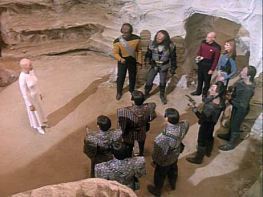 Now this was one I didn't much like, but it's an example of the concept of ancient astronauts nonetheless. And it comes to us courtesy of Star Trek: TNG. from an episode named "The Chase" (episode 146). In it, Picard's old friend and mentor turns up dead in the course of an expedition which he claims could be the most profound discovery of their time.
Now this was one I didn't much like, but it's an example of the concept of ancient astronauts nonetheless. And it comes to us courtesy of Star Trek: TNG. from an episode named "The Chase" (episode 146). In it, Picard's old friend and mentor turns up dead in the course of an expedition which he claims could be the most profound discovery of their time.
After retracing his footsteps, Picard and the Enterprise are joined by three other search parties – one Klingon, one Romulan and one Cardassian – in orbit around a dead planet. When they reach the surface, they find that all the clues lead to a recording left behind by an ancient species. In the recording, the humanoid alien tells them all that they are the progenitors of every sentient race in the quadrant, that their DNA was planted on countless worlds. This is apparently why so many species are humanoid, and means that humanity shares ancestry with all these would-be enemies.
Heartwarming, and kind of cool if it weren't such a convenient explanation as to why all aliens in the Star Trek franchise are humanoid. This is something that's always annoyed me about the franchise. It's not enough that all the aliens speak English and look like people, minus the occasional molded plastic on their faces. But to make matters worse, they always got to make a point of drawing attention to their humanoid forms. So when it came right down to it, this episode felt more like a contrived explanation than a homage. Personally, I would have thought that limited budgets would be the reason, but what do I know? I'm no xenobiologist!
The First Ones:
Another favorite which comes to us courtesy of the Babylon 5 universe. According to the expanded storyline, the First Ones were the first beings to achieve sentience in the Milky Way Galaxy. By the time of the show, most of them had left our corner of the universe in order to explore other galaxies and what lies between them. Only two remains behind, ostensibly to act as shepherds to the younger races. They were known as the Vorlons and the Shadows. However, in time, the two races turned on each other because of their diametrically opposed
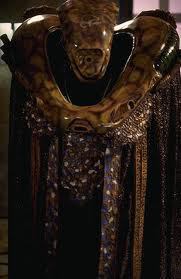 The Vorlons believed that development and progress came from order. In the course of their long history, they travelled to many worlds inhabited by sentient races and manipulated their evolution. In each case, they presented themselves as angels, thus ensuring that sentient beings would see them as creatures of light and truth. In addition, they fostered the development of telepaths for use in coming wars against the Shadows, whom they knew to vulnerable to psionics.
The Vorlons believed that development and progress came from order. In the course of their long history, they travelled to many worlds inhabited by sentient races and manipulated their evolution. In each case, they presented themselves as angels, thus ensuring that sentient beings would see them as creatures of light and truth. In addition, they fostered the development of telepaths for use in coming wars against the Shadows, whom they knew to vulnerable to psionics.
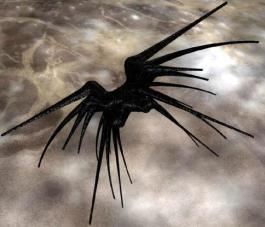 The Shadows, on the other hand, believe that evolution comes through chaos. In the course of their history, they travelled to many worlds as well and encouraged different peoples to war with each other. This, they reasoned, would lead to the development of stronger races. Those that died off were sacrificed for the greater good, while those that survived emerged more powerful and advanced.
The Shadows, on the other hand, believe that evolution comes through chaos. In the course of their history, they travelled to many worlds as well and encouraged different peoples to war with each other. This, they reasoned, would lead to the development of stronger races. Those that died off were sacrificed for the greater good, while those that survived emerged more powerful and advanced.
This philosophy led them into conflict with the Vorlons as well as many other of the First Ones. Many younger races found themselves taking sides or getting caught in the middle. In fact, wars between the two sides became a recurring thing, happening every few thousand years. In the last, the Shadows had been defeated and left the known universe. But as the story opens, they are once again returning to their old stomping grounds, a planet known as Z'ha'dum.
This world is doubly significant because another First One, THE first one in fact, resides there. His name is Lorien, and he is the last of his kind and the sole First One who is allowed the return to the Galaxy. All of the others long since abandoned it, leaving the Shadows and Vorlons to their war and the races they choose to enlist. In the end, however, the main characters reject their agenda and form their own alliance to thwart them. They are successful, and both races leave with Lorien, never to return. In the last episode, Sheridan is on the verge of death when he is found contacted by Lorien who then takes him with him to the great beyond where the other First Ones now reside.
The Forerunners: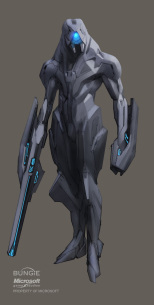 Now here is an interesting take on the whole ancient astronauts concept. Whereas in most versions of this idea, aliens make contact with a younger race and influence them for their purposes. However, in the Halo universe, things happen in a sort of reverse order. Eons after dying out, the Covenant races came upon the remains of the Forerunners and interpreted them to be holy relics which they began to reverse-engineer so they could merge it with their own technology. This, in turn, led them to develop an entire religion and theocracy based on the Forerunners and the signifance of their most important relics: the Halo devices.
Now here is an interesting take on the whole ancient astronauts concept. Whereas in most versions of this idea, aliens make contact with a younger race and influence them for their purposes. However, in the Halo universe, things happen in a sort of reverse order. Eons after dying out, the Covenant races came upon the remains of the Forerunners and interpreted them to be holy relics which they began to reverse-engineer so they could merge it with their own technology. This, in turn, led them to develop an entire religion and theocracy based on the Forerunners and the signifance of their most important relics: the Halo devices.
So in this way, the Forerunners had a profound impact on the development and beliefs of the Covenant, but not intentionally. And in the end, this influence had a near disastrous effect. Given that they believed the Halos to be holy relics that would lead them on the "great journey" the Covenant very nearly caused their own extinction. One would think there was a message in all this about the dangers of blind faith or something!
The Orions: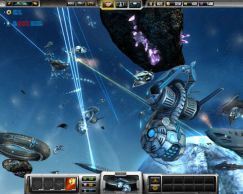 In the video game series Master of Orion, there is yet another take on the concepts of ancients aliens. In this turn-based strategy game, players select from different alien races that inhabit the galaxy and begin the process of colonization and expansion. In time, the concept of the Orions comes up. It seems that each race, though they are different and possess varying special abilities, have their own legends about this particular race.
In the video game series Master of Orion, there is yet another take on the concepts of ancients aliens. In this turn-based strategy game, players select from different alien races that inhabit the galaxy and begin the process of colonization and expansion. In time, the concept of the Orions comes up. It seems that each race, though they are different and possess varying special abilities, have their own legends about this particular race.
One of the aspects of the game is to find the Orions homeworld, a place full of secret and advanced technology, but which is defended by a powerful robotic starship known as the Guardian. Whoever is able to destroy this ship and land on the planet is the most likely to win the game.
The Xel'naga: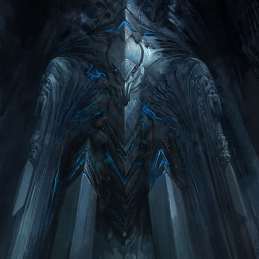 Another example of this concept which comes to us from the gaming world. of which fans of Starcraft will no doubt be instantly familiar with! Translated literally as "Wanders from Afar", the Xel'naga were apparently a race from a distant galaxy that was concerned with creating the perfect life form. In the course of their lifetime, they apparent "seeded and cultivated thousands of various species" (from the SC game handbook). This included the Protoss and Zerg, two of the major players in the game, and figures pretty prominently in the game's backstory.
Another example of this concept which comes to us from the gaming world. of which fans of Starcraft will no doubt be instantly familiar with! Translated literally as "Wanders from Afar", the Xel'naga were apparently a race from a distant galaxy that was concerned with creating the perfect life form. In the course of their lifetime, they apparent "seeded and cultivated thousands of various species" (from the SC game handbook). This included the Protoss and Zerg, two of the major players in the game, and figures pretty prominently in the game's backstory.
In the case of the Protoss, the Xel'naga thought that they had found beings that possessed "purity of form" and began manipulating them. However, when they revealed themselves to the Protoss, the latter turned on them and they fled. They discovered the Zerg shortly thereafter, a species which they believed possessed "purity of essence". They began by enhancing them from the small, parasitic larvae that they were, but found that they were too primitive. They therefore developed the Overmind as well to give them purpose and direction, but this only made matters worse. In time, the Zerg found the Xel'naga, who had chosen to remain hidden this time, and consumed them.
In the course of the game, Xel'naga ruins make only one appearance, in the form of an ancient temple which possesses the ability to sterilize the planet of all other species. However, other ruins are apparently featured in one of the game's novelizations. Otherwise their is no mention of them, their existence merely constituting part of the story's deep background.
Like I said, its a cool concept. And wouldn't it be cool if it were actually true? I mean, no one can prove aliens didn't mess with our evolution, right? Yeah, it's not exactly a sound basis for a scientific theory, but a very fertile source for science fiction!











